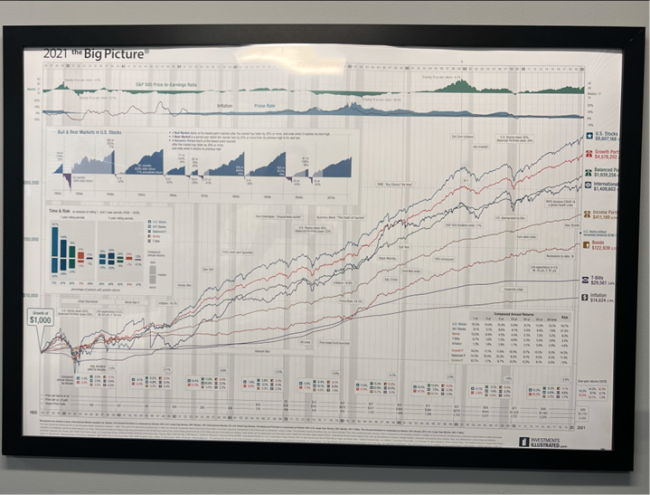
Non-Value Added Stress
Two weeks ago, I joined 3,000 other industry professionals at a conference in Huntington Beach, California.
For those who have been with us for a while and are avid readers of our postings, this is the same conference I attended and wrote about last year. The conference had all of the highs from last year, with beaches, sunsets, and a lot of great conversations with my fellow planners.
Another positive is that markets were pretty calm during the trip. On the third day of my trip last year, markets fell by 4%. What started as a very sunny day quickly became cloudy on heightened concerns of sticky inflation and higher interest rates.
This year, markets were nice enough to wait for me to get back before falling. Due in large part to the Fed, as well as concerns surrounding a possible government shutdown, the S&P 500 is down about 4.5%, with smaller companies being down a touch more.
During a recent client meeting, the individual we were speaking to brought up a very interesting concept: non-value-added stress. The idea is that we worry a lot about things that don't add positivity to our daily lives.
Unfortunately, we see this a lot in the financial world. And don't get me wrong, it's entirely warranted to have some concern. After all, it's your hard-earned money that's being considered. These are funds that are meant to support you in the future.
Throughout our meetings with all of you, we are often presented with the following question: "What is your current market outlook?". This is one of the most challenging questions to answer for myself, and likely some of my advisory teammates.
We live in a world of unknowns, and the market is very fickle. Without warning, markets can turn one way or another based on the words and actions of a few high-ranking people or even by economic data points that may miss by a tenth or hundredth of a percent. Small things can alter the present in a big way, and this alteration can happen very fast.
For those of you who have joined us for in-person meetings, you have probably noticed various visuals placed around our office. When we first moved into our office space in 2020, we wanted to be very intentional about the pictures and illustrations on our walls. Our goal was to remind clients and ourselves of why we do what we do. As mentioned above, we live in a world of unknowns. These help to ground us and remind us of the reasons we make the decisions we make.
The picture below was drawn by Carl Richards, one of our industry's best thought leaders. He's well known for taking complex ideas and drawing them in simple forms. For example…
I like this picture because it presents a great reminder that so much of the financial world is outside of our control. We say it a lot, but the amount of money that trades hands around the globe each day is nearly impossible to conceptualize. We're talking about trillions of dollars and ideas being moved across various channels. Yes, there are a few people who can make markets move in the short term. However, nobody can dictate which direction markets will go over long periods.
This leads to the next illustration we have framed in our conference room…
The purpose behind this visual is to remind us that anything can happen in small periods of time. But when we zoom out and look at the big picture, the trend is up and to the right.
There is a famous quote in the investment world whose originator I could not track down. The individual says, "If losing sleep would make markets go up, then you can bet I would stay up all night."
It's easy to lose sleep when you see the dollars on statements going down. But at the end of the day, the stress and worry don't add value to your everyday lives, nor do they add value to the portfolio.
My preference during times of volatility is to focus on the things I can control. This includes not panicking and selling out while markets are down. It also includes paying attention to the allocation of portfolios.
One of the brightest minds in the financial world is that of the late Harry Markowitz. Dr. Markowitz, who unfortunately passed away this past June, won his Nobel Prize for his work in Market Theory in 1990. Among his many famous quotes, he's known for saying that "Diversification is the only free lunch" in investing.
When market volatility rears its ugly head, it's important to make sure that you stay diversified. This means holding assets in stock and bonds, domestically and internationally, and across larger and smaller companies.
The people who get bit the hardest when markets start to fall are those who put all their eggs in one basket. The only way to ensure you always have something holding its value or even going up is to own a broad array of assets. To steal a saying from Joe (who probably stole it from someone else), if everything in your portfolio is going down at the same time, you are not diversified.
Diversification, when paired with a proper rebalancing strategy, is what we at Pitzl Financial focus on and preach. In our portfolios, which include the dollars we personally have invested, we focus on owning portions of each sector mentioned above. We know that markets go up and to the right over time, but it doesn't happen all at once. As long as we have some assets outperforming, we put ourselves in the best position for the future.
When it comes down to it, the investment world is built on a lack of control for investors. On a day-to-day basis, nobody can control what an individual stock or market will do. Rather than focusing on what we can't control, we should direct our attention to what we can control. This tends to be a better exercise in offering value-added stress.



